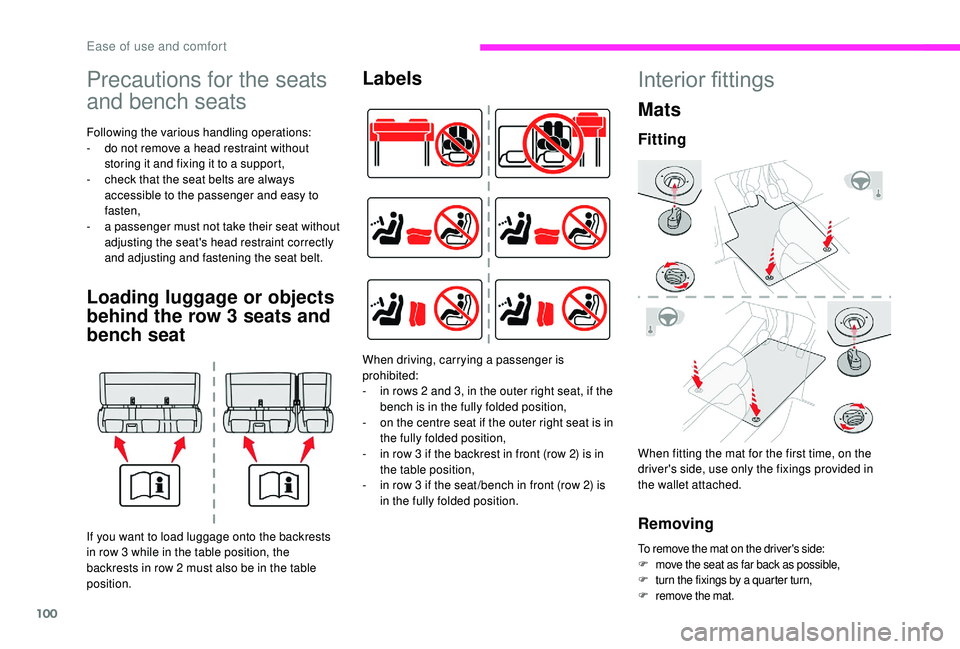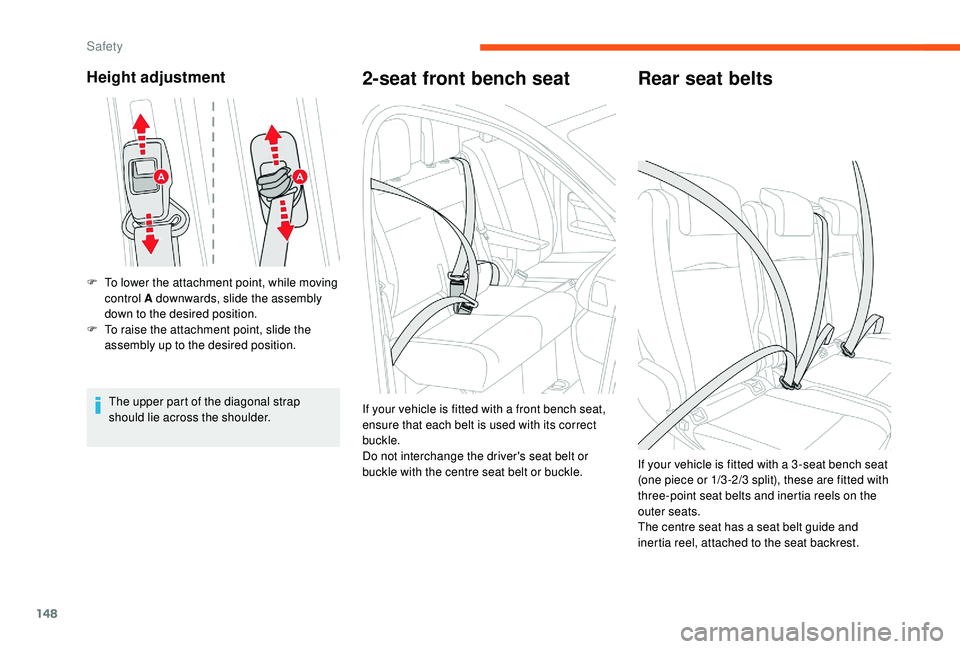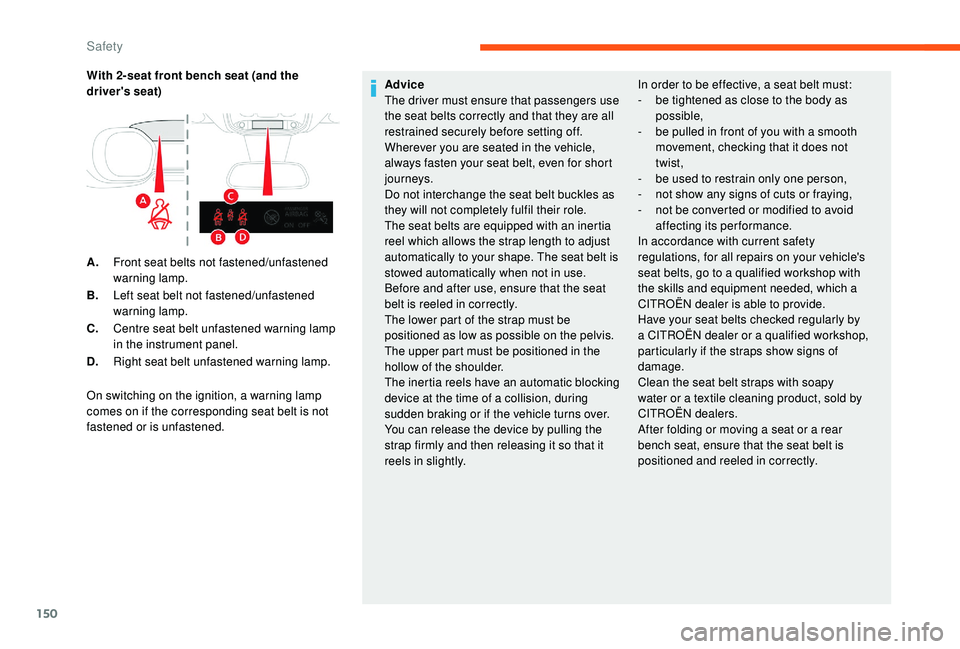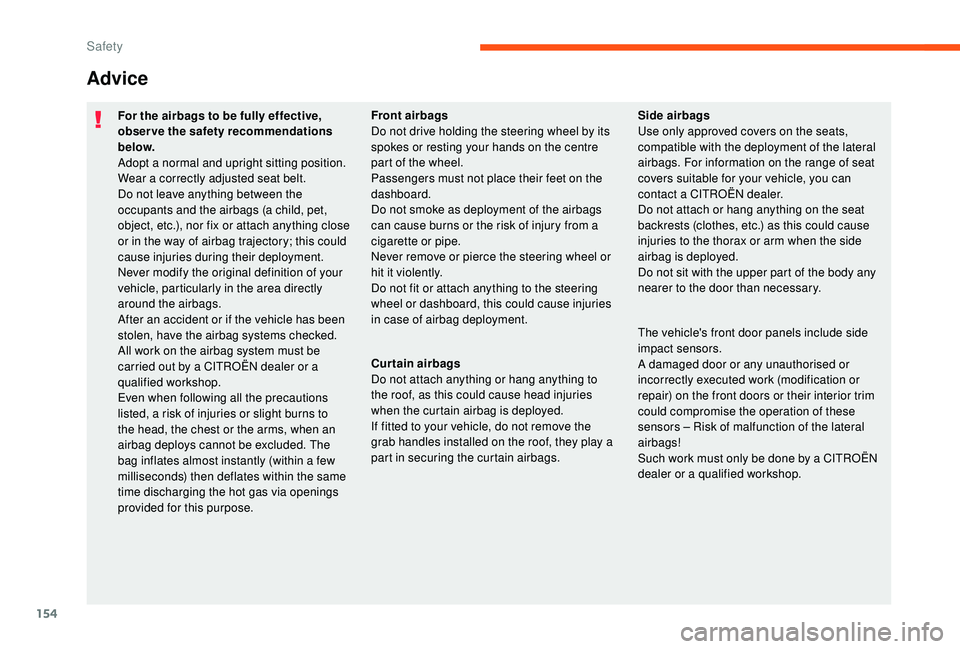belt CITROEN DISPATCH SPACETOURER 2018 Handbook (in English)
[x] Cancel search | Manufacturer: CITROEN, Model Year: 2018, Model line: DISPATCH SPACETOURER, Model: CITROEN DISPATCH SPACETOURER 2018Pages: 400, PDF Size: 16.99 MB
Page 102 of 400

100
Precautions for the seats
and bench seats
Following the various handling operations:
- d o not remove a head restraint without
storing it and fixing it to a support,
-
c
heck that the seat belts are always
accessible to the passenger and easy to
fasten,
-
a p
assenger must not take their seat without
adjusting the seat's head restraint correctly
and adjusting and fastening the seat belt.
Loading luggage or objects
behind the row 3 seats and
bench seat
If you want to load luggage onto the backrests
in row 3
while in the table position, the
backrests in row 2
must also be in the table
position.
LabelsInterior fittings
Mats
Fitting
When fitting the mat for the first time, on the
driver's side, use only the fixings provided in
the wallet attached.
Removing
To remove the mat on the driver's side:
F m ove the seat as far back as possible,
F
t
urn the fixings by a quarter turn,
F
r
emove the mat.
When driving, carrying a passenger is
prohibited:
-
i
n rows 2 and 3, in the outer right seat, if the
bench is in the fully folded position,
-
o
n the centre seat if the outer right seat is in
the fully folded position,
-
i
n row 3 if the backrest in front (row 2) is in
the table position,
-
i
n row 3 if the seat /bench in front (row 2) is
in the fully folded position.
Ease of use and comfort
Page 149 of 400

147
Seat belts
Front seat belts
Fastening
Unfastening
F Press the red button on the buckle.
F G uide the seat belt as it reels in.
The front seat belts are fitted with a
pretensioning and force limiting system.
This system improves safety in the front
seats in the event of a front or side impact.
Depending on the severity of the impact, the
pretensioning system instantly tightens the seat
belts against the body of the passengers. The pretensioning seat belts are active when
the ignition is on.
The force limiter reduces the pressure of the
seat belt on the chest of the passenger, so
improving their protection.
F
P
ull the strap then insert the tongue in the
buckle.
F
C
heck that the seat belt is fastened
correctly by pulling the strap.
Driving recommendations
Your vehicle is designed principally to
drive on tarmac roads but it allows you to
occasionally drive on other less passable
terrain.
However, it does not permit off-road
driving such as:
-
c
rossing and driving on terrain which
could damage the underbody or strip
away components (fuel pipe, fuel
cooler, etc.) due to obstacles or stones
in particular,
-
d
riving on terrain with steep gradients
and poor grip,
-
c
rossing a stream.
5
Safety
Page 150 of 400

148
Height adjustment
F To lower the attachment point, while moving control A downwards, slide the assembly
down to the desired position.
F
T
o raise the attachment point, slide the
assembly up to the desired position.
The upper part of the diagonal strap
should lie across the shoulder.
2-seat front bench seat
If your vehicle is fitted with a front bench seat,
ensure that each belt is used with its correct
buckle.
Do not interchange the driver's seat belt or
buckle with the centre seat belt or buckle.
Rear seat belts
If your vehicle is fitted with a 3 -seat bench seat
(one piece or 1/3 -2/3 split), these are fitted with
three-point seat belts and inertia reels on the
outer seats.
The centre seat has a seat belt guide and
inertia reel, attached to the seat backrest.
Safety
Page 151 of 400

149
For rows 2 and 3, fit each seat belt to its
c orrect buckle.
Do not interchange the belts or buckles for
the outer seats with the belt or buckle for
the centre seat.
When folding the outer seats or placing
a backrest in the table position, avoid
trapping the belt for the centre seat.
After folding a rear seat or bench seat,
ensure that the seat belt has reeled
in correctly and the buckle is ready to
receive the belt tongue.
When handling the outer seats (removing
or refitting) or for access to row 3, avoid
trapping the centre belt.
The seat belt reels for the outer seats in row
2
have force limiters.
The seats in row 3 have three-point seat belts
with inertia reels.
With individual seats
They have three-point seat belts with their
guides and belt reels built into the backrests.
Seat belt warning lamps
With individual front seats
On switching on the ignition, a warning lamp
comes on if the corresponding seat belt is not
fastened or is unfastened.
From approximately 12
mph (20 km/h),
the warning lamp(s) flash for two
minutes, associated with an audible
signal. Beyond these two minutes, the
warning lamps remain on if the driver
or front passenger do not fasten their
seat belt(s).
1.
Front seat belts not fastened/unfastened
warning lamp.
2. Left seat belt not fastened/unfastened
warning lamp.
3. Right seat belt not fastened/unfastened
warning lamp.
5
Safety
Page 152 of 400

150
With 2-seat front bench seat (and the
driver's seat)
On switching on the ignition, a warning lamp
comes on if the corresponding seat belt is not
fastened or is unfastened.Advice
The driver must ensure that passengers use
the seat belts correctly and that they are all
restrained securely before setting off.
Wherever you are seated in the vehicle,
always fasten your seat belt, even for short
journeys.
Do not interchange the seat belt buckles as
they will not completely fulfil their role.
The seat belts are equipped with an inertia
reel which allows the strap length to adjust
automatically to your shape. The seat belt is
stowed automatically when not in use.
Before and after use, ensure that the seat
belt is reeled in correctly.
The lower part of the strap must be
positioned as low as possible on the pelvis.
The upper part must be positioned in the
hollow of the shoulder.
The inertia reels have an automatic blocking
device at the time of a collision, during
sudden braking or if the vehicle turns over.
You can release the device by pulling the
strap firmly and then releasing it so that it
reels in slightly.
A.
Front seat belts not fastened/unfastened
warning lamp.
B. Left seat belt not fastened/unfastened
warning lamp.
C. Centre seat belt unfastened warning lamp
in the instrument panel.
D. Right seat belt unfastened warning lamp. In order to be effective, a seat belt must:
-
b
e tightened as close to the body as
possible,
-
b
e pulled in front of you with a smooth
movement, checking that it does not
twist,
-
b
e used to restrain only one person,
-
n
ot show any signs of cuts or fraying,
-
n
ot be converted or modified to avoid
affecting its performance.
In accordance with current safety
regulations, for all repairs on your vehicle's
seat belts, go to a qualified workshop with
the skills and equipment needed, which a
CITROËN dealer is able to provide.
Have your seat belts checked regularly by
a CITROËN dealer or a qualified workshop,
particularly if the straps show signs of
damage.
Clean the seat belt straps with soapy
water or a textile cleaning product, sold by
CITROËN dealers.
After folding or moving a seat or a rear
bench seat, ensure that the seat belt is
positioned and reeled in correctly.
Safety
Page 153 of 400

151
Instructions for children
Use a suitable child seat, if the passenger
is less than 12 years old or shorter than
one and a half metres.
Never use the same seat belt to secure
more than one person.
Never allow a child to travel on your lap.
For more information on Child seats , refer
to the corresponding section.
In case of impact
Depending on the nature and seriousness
of the impact, the pyrotechnic may be
deployed before and independent of the
airbags. Deployment of the pyrotechnics
is accompanied by a slight discharge of
harmless smoke and a noise, due to the
activation of the pyrotechnic cartridge
incorporated in the system.
In all cases, the airbag warning lamp is lit.
After an impact, get the seat belt system
checked and if necessary have it replaced
by a CITROËN dealer or a qualified
workshop.AirbagsThe airbags do not operate when the
ignition is switched off.
This equipment will only deploy once. If a
second impact occurs (during the same or
a subsequent accident), the airbag will not
be deployed again.
Impact detection zones
A. Frontal impact zone.
B. S ide impact zone.
System designed to contribute towards
improving the safety of passengers (with the
exception of the centre seat in rows 2
and
3, depending on your vehicle) in the event of
violent collisions. The airbags supplement the
effect of the seat belts with force limiter.
If a collision occurs, the electronic detectors
record and analyse the front and side impacts
sustained in the impact detection zones:
-
i
n the event of a serious impact, the airbags
are deployed instantly and contribute
towards better protection of the passengers
(with the exception of the centre seat in
rows 2
and 3, as applicable); immediately
after the impact, the airbags deflate rapidly
so that they do not hinder visibility or the
exit of the passengers,
-
i
n the case of a minor or rear impact or in
certain roll-over conditions, the airbags
may not be deployed; the seat belt
alone contributes towards ensuring your
protection in these situations.
5
Safety
Page 156 of 400

154
Advice
For the airbags to be fully effective,
observe the safety recommendations
below.
Adopt a normal and upright sitting position.
Wear a correctly adjusted seat belt.
Do not leave anything between the
occupants and the airbags (a child, pet,
object, etc.), nor fix or attach anything close
or in the way of airbag trajectory; this could
cause injuries during their deployment.
Never modify the original definition of your
vehicle, particularly in the area directly
around the airbags.
After an accident or if the vehicle has been
stolen, have the airbag systems checked.
All work on the airbag system must be
carried out by a CITROËN dealer or a
qualified workshop.
Even when following all the precautions
listed, a risk of injuries or slight burns to
the head, the chest or the arms, when an
airbag deploys cannot be excluded. The
bag inflates almost instantly (within a few
milliseconds) then deflates within the same
time discharging the hot gas via openings
provided for this purpose.Front airbags
Do not drive holding the steering wheel by its
spokes or resting your hands on the centre
part of the wheel.
Passengers must not place their feet on the
dashboard.
Do not smoke as deployment of the airbags
can cause burns or the risk of injury from a
cigarette or pipe.
Never remove or pierce the steering wheel or
hit it violently.
Do not fit or attach anything to the steering
wheel or dashboard, this could cause injuries
in case of airbag deployment.
Side airbags
Use only approved covers on the seats,
compatible with the deployment of the lateral
airbags. For information on the range of seat
covers suitable for your vehicle, you can
contact a CITROËN dealer.
Do not attach or hang anything on the seat
backrests (clothes, etc.) as this could cause
injuries to the thorax or arm when the side
airbag is deployed.
Do not sit with the upper part of the body any
nearer to the door than necessary.
Curtain airbags
Do not attach anything or hang anything to
the roof, as this could cause head injuries
when the curtain airbag is deployed.
If fitted to your vehicle, do not remove the
grab handles installed on the roof, they play a
part in securing the curtain airbags. The vehicle's front door panels include side
impact sensors.
A damaged door or any unauthorised or
incorrectly executed work (modification or
repair) on the front doors or their interior trim
could compromise the operation of these
sensors – Risk of malfunction of the lateral
airbags!
Such work must only be done by a CITROËN
dealer or a qualified workshop.
Safety
Page 157 of 400

155
General points relating to
child seats
* The legislation on carrying children is specific to each country.
Although one of CITROËN's main
considerations when designing your vehicle,
the safety of your children also depends on
you.
For maximum safety, please obser ve the
following recommendations:
-
I
n accordance with European regulations,
all children under the age of 12 or less
than one and a half metres tall must
travel in an approved child seat suited to
their weight and installed on a vehicle seat
fitted with a seat belt or ISOFIX mountings*.
-
S
tatistically, the safest seats in your
vehicle for carr ying children are the rear
seats.
-
A c
hild weighing less than 9 kg must
travel in the rear ward facing position
both in the front and in the rear.
CITROËN recommends that children
should travel on the rear seats of your
vehicle:
-
re
arward facing
up to the age of 3,
-
fo
rward facing
over the age of 3.
Child seat at the rear
Row 2
"Rearward facing"
When a "rear ward facing" child seat is installed
on a rear passenger seat , move the vehicle's
front seat for ward and straighten the backrest
so that the rear ward facing child seat does not
touch the vehicle's front seat.
Adjust the rear seat to the fully back position,
with the backrest straightened.
"Forward facing"
Ensure that the seat belt is properly
tightened.
For child seats with a support leg, ensure
that this is in firm contact with the floor.
If necessary, adjust the front seat of the
vehicle.
When a "for ward facing" child seat is installed
on a rear passenger seat
, move the vehicle's
front seat for ward and straighten the backrest
so that the legs of the child in the for ward
facing child seat do not touch the vehicle's front
seat.
Adjust the rear seat to the fully back position,
with the backrest straightened.
5
Safety
Page 158 of 400

156
Row 3
If fitted to your vehicle, when a child seat is
installed on a passenger seat in the 3rd row,
move the seats in the 2nd row for ward and
straighten the backrests so that the child seat
and the child's legs do not touch the seats in
the 2nd row.
Child seat at the front
"Rearward facing"
The passenger's front airbag must be
deactivated. Otherwise, the child risks
being seriously injured or killed if the
airbag is deployed.
When a rear ward facing child seat is installed
on the front passenger seat
, adjust the seat
to the fully back and highest position, with the
backrest straightened.
"Forward facing"
When a for ward facing child seat is installed on
the front passenger seat , adjust the vehicle's
seat to the fully back and highest position with
the seat backrest straightened and leave the
passenger's front airbag activated.
Ensure that the seat belt is properly
tightened.
For child seats with a support leg, ensure
that this is in firm contact with the floor. If
necessary, adjust the passenger seat.
(Refer to the current legislation in your country
before installing your child on this seat.)
Safety
Page 160 of 400

158
F With the ignition off, insert the key in the
passenger airbag deactivation switch.
F
T
urn it to the OFF position.
F
R
emove the key, leaving the switch in this
position.
When the ignition is switched on, this
warning lamp comes on in the seat
belt warning display screen. It stays on
while the airbag is deactivated. To ensure the safety of your child,
the passenger front airbag must be
deactivated when you install a rear ward
facing child seat on the front passenger
seat.
Other wise, there is a risk of serious or
fatal injury to the child if the airbag is
deployed.
Reactivation
When you remove the child seat, with the
ignition off
, turn the switch to the ON position
to reactivate the airbag and so assure the
safety of your front passenger(s) in the event of
an impact.
When the ignition is switched on,
this warning lamp comes on in the
seat belt warning display screen for
approximately one minute to signal
that the front airbag is activated.
Deactivation
Safety